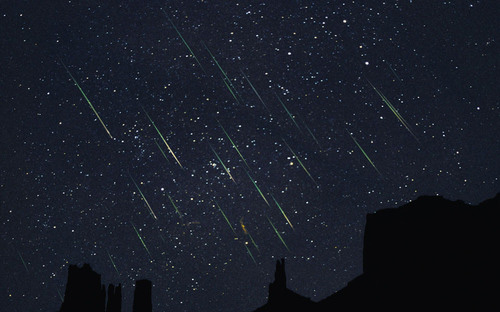
Weather conditions permitting, stargazers can get their last treat for 2012 with the annual Geminids meteor shower, which peaks on the night of December 13.
PAGASA administrator Nathaniel Servando said as many as 40 meteors per hour can be seen under a "dark and cloudless sky" after midnight of Dec. 13. The annual Geminids meteor shower will reach its peak in the night of December 13-14. Under a dark and cloudless sky just after midnight of its peak activity, meteors or 'falling stars' can be seen at an average rate of forty meteors per hour. The shower will appear to radiate from the constellation of Gemini, the Twin. Aside from the meteor show, the equilateral "Winter Triangle" will rise after sunset.
The triangle includes Betelgeuse, the super giant red star and the prominent star of the famous constellation Orion; Sirius, the brightest star in the sky of the constellation Canis Major; and Procyon, the brightest star of the constellation Canis Minor.
Winter solstice
The winter solstice will take place December 21 at 7:12 p.m. (Philippine Standard Time). Which marks the time when the Sun lies at its farthest point south of the equator. It signals the onset of winter in the Northern Hemisphere and summer in the Southern Hemisphere. After this, the Philippine nights will be longer than daytime.
Planets
Saturn, Venus and Mercury will line up in the east-southeastern sky until the last week of December, as Venus and Mercury continue to slide down the horizon. It will be a spectacular view with the naked eye and will be a best time for photography, telescoping and binocular viewing.
Mars will remain visible a little over 12 degrees above the west-southwestern horizon, an hour after sunset throughout the month. It will be traversing the background stars of the constellation Sagittarius for the rest of the month, and glow at magnitude +1.2 and will appear as a small blurry orange at 4.5 degrees of an arc in a modest size telescope.
Uranus and Neptune will be found at the zenith an hour after sunset during the month. They will lie among the background stars of the constellations Pisces and Aquarius. Uranus will glow at magnitude +5.7 while Neptune will be faint at magnitude +7.8.
A binocular or a telescope and a star map will be needed to observe the two planets, which will be observable in the evening sky throughout the month.
Meanwhile, Jupiter will rise around sunset above the eastern horizon and will shine at magnitude -2.8 and will lie among the background stars of the constellation Taurus. It will move in a retrograde motion (westward with respect to the background stars) toward Aldebaran, the prominent star of the constellation Taurus. Jupiter’s distance from Aldebaran decreases about 5 degrees during the month. Jupiter will be pairing spectacularly with the Moon on the 25th and 26th of the month.
Perfect opportunity to go stargazing with family and loved ones to enjoy the Christmas season!
Source: Yahoo! & GMA News
